Study on the Diurnal Difference of the Impact Mechanism of Urban Green Space on Surface Temperature and Sustainable Planning Strategies
Abstract
1. Introduction
2. Materials and Methods
2.1. Study Area
2.2. Land Use Data and Land Surface Temperature
2.3. Construction and Validation of Green Space Morphological Indicators
2.4. Model Construction
2.4.1. Machine Learning Models
2.4.2. SHAP Model
2.5. Technical Framework
3. Results
3.1. Data Validation and Model Comparison
3.1.1. p-Values, VIF Tests and Pearson Heatmaps
3.1.2. Comparison of Machine Learning Models
3.2. The Relative Importance of Green Space Variables
3.3. The Marginal Effects of Green Space Variableon Daytime and Nighttime LST
3.4. Interaction of Green Space Variable
4. Discussion
4.1. The Predominant Factors Influencing the Cooling Effect of Green Spaces
4.2. Interaction Effects of Green Space Variables
4.3. Green Space Construction Planning Recommendations for Cities to Address the Urban Heat Island Effect
4.4. Limitations
5. Conclusions
- (1)
- Machine learning models accurately reveal urban thermal environment mechanisms.
- (2)
- Green spaces exert diurnal variations and structure-dependent influences on LST.
- (3)
- Green space indicators exhibit non-linear thresholds and scale effects.
- (4)
- Diurnal variations in urban thermal regulation mechanisms.
Author Contributions
Funding
Institutional Review Board Statement
Informed Consent Statement
Data Availability Statement
Conflicts of Interest
References
- Lan, F.; Da, H.L.; Wen, H.Z.; Wang, Y. Spatial Structure Evolution of Urban Agglomerations and Its Driving Factors in Mainland China: From the Monocentric to the Polycentric Dimension. Sustainability 2019, 11, 610. [Google Scholar] [CrossRef]
- Luo, H.F.; Wu, J.L. Effects of urban growth on the Land Surface Temperature: A case study in Taiyuan, China. Environ. Dev. Sustain. 2020, 23, 10787–10813. [Google Scholar] [CrossRef]
- Xu, Z.X.; Cai, Z.L.; Su, S.L.; Kang, M.J.; Ge, Y. Unraveling the association between the urban polycentric structure and urban surface thermal environment in urbanizing China. Sustain. Cities Soc. 2022, 76, 103490. [Google Scholar] [CrossRef]
- Ma, X.L.; Peng, S.Y. Assessing the quantitative relationships between the impervious surface area and surface heat island effect during urban expansion. Peerj 2021, 9, e11854. [Google Scholar] [CrossRef]
- Rizwan, A.M.; Dennis, Y.C.L.; Liu, C.H. A review on the generation, determination and mitigation of Urban Heat Island. J. Environ. Sci. 2008, 20, 120–128. [Google Scholar] [CrossRef]
- Huang, H.C.; Deng, X.; Yang, H.L.; Li, S.M.; Li, M.Y. Spatial Evolution of the Effects of Urban Heat Island on Residents’ Health. Teh. Vjesn.-Tech. Gaz. 2020, 27, 1427–1435. [Google Scholar] [CrossRef]
- Liu, S.D.; Zhang, J.J.; Wu, X.; Chen, W.; Zhang, J. Potential thermal constraints for sustainable industrial city: Refined simulation and prediction of extreme urban heat island effect. Sustain. Cities Soc. 2024, 105, 105342. [Google Scholar] [CrossRef]
- He, B.J.; Wang, J.S.; Liu, H.M.; Ulpiani, G. Localized synergies between heat waves and urban heat islands: Implications on human thermal comfort and urban heat management. Environ. Res. 2021, 193, 110584. [Google Scholar] [CrossRef]
- Niu, Z.P.; Fang, X.Y.; Sun, J.; Du, S.; Tang, H.; Shao, W.P.; Chen, T.Y.; Nie, J.; Yu, Z.W.; Yao, X.H.; et al. Exposure to Anthropogenic Heat Was Associated with the Increased Risks of Respiratory Allergy Symptoms in Preschool Children: A New Insight into the Urban Heat Island Effect. Environ. Sci. Technol. 2025, 59, 12060–12073. [Google Scholar] [CrossRef]
- Uriarte-Otazua, U.; Azkorra-Larrinaga, Z.; Varela-Alonso, M.; Gomez-Arriaran, I.; Irulegi-Garmendia, O. Impact of Heat Waves on the Well-Being and Risks of Elderly People Living Alone: Case Study in Urban and Peri-Urban Dwellings in the Atlantic Climate of Spain. Buildings 2025, 15, 2274. [Google Scholar] [CrossRef]
- Hao, M.; Liu, X.; Li, X. Quantifying heat-related risks from urban heat island effects: A global urban expansion perspective. Int. J. Appl. Earth Obs. Geoinf. 2025, 136, 104344. [Google Scholar] [CrossRef]
- Jia, R.Y.; Liu, J.W.; He, T.; Han, D.R.; Xu, X.L.; Liu, L.; Sun, Z.Y.; Qiao, Z. Population heat exposure risk from the perspective of urban heat island spatial expansion in China during 2005–2020. Urban Clim. 2024, 56, 101987. [Google Scholar] [CrossRef]
- Xu, Y.T.; Jia, R.Y.; Liu, J.W.; Han, D.R.; He, T.; Xu, X.L.; Liu, L.; Sun, Z.Y.; Qiao, Z. The population exposure risk of urban heat island effect: From the perspective of urban spatial expansion in China. Build. Environ. 2024, 258, 11565. [Google Scholar] [CrossRef]
- Sun, Y.M.; Augenbroe, G. Urban heat island effect on energy application studies of office buildings. Enegy Build. 2014, 77, 171–179. [Google Scholar] [CrossRef]
- Ying, J.; Zhang, X.J.; Zhang, Y.Q.; Bilan, S. Green infrastructure: Systematic literature review. Econ. Res.-Ekon. Istraz. 2021, 35, 343–366. [Google Scholar] [CrossRef]
- Tzoulas, K.; Korpela, K.; Venn, S.; Yli-Pelkonen, V.; Kazmierczak, A.; Niemela, J.; James, P. Promoting ecosystem and human health in urban areas using Green Infrastructure: A literature review. Landsc. Urban Plan. 2007, 81, 167–178. [Google Scholar] [CrossRef]
- Zepp, H.; Gessner, M.; Gruenhagen, L.; Bührs, M. Modeling the cooling effect of urban green spaces: The neglected control variables of ‘soil moisture’ and ‘biotope types’. Urban For. Urban Green. 2023, 90, 128137. [Google Scholar] [CrossRef]
- Cheng, H.J.; Han, Y.H.; Park, C. Quantitative analysis of differences in cooling effect and efficiency after changes in Green Infrastructure Types (GIT). Sustain. Cities Soc. 2025, 119, 106101. [Google Scholar] [CrossRef]
- Zhao, J.C.; Zhao, X.; Liang, S.L.; Wang, H.Y.; Liu, N.J.; Liu, P.; Wu, D.H. Dynamic Cooling Effects of Permanent Urban Green Spaces in Beijing, China. Remote Sens. 2021, 13, 3282. [Google Scholar] [CrossRef]
- Wu, Q.Y.; Huang, Y.H.; Irga, P.; Kumar, P.; Li, W.G.; Wei, W.; Shon, H.K.; Lei, C.W.; Zhou, J.L. Synergistic control of urban heat island and urban pollution island effects using green infrastructure. J. Environ. Manag. 2024, 370, 122985. [Google Scholar] [CrossRef]
- Zhang, J.X.; Zhao, J.Y.; Pang, B.; Liu, S.S. Calculation of the Optimal Scale of Urban Green Space for Alleviating Surface Urban Heat Islands: A Case Study of Xi’an, China. Land 2024, 13, 1043. [Google Scholar] [CrossRef]
- Moon, S.Y.; Kim, J.; Chong, W.K.O.; Ariaratnam, S.T. Urban Green Space Layouts and Urban Heat Island: Case Study on Apartment Complexes in South Korea. J. Urban Plan. Dev. 2018, 144, 04018004. [Google Scholar] [CrossRef]
- Liu, Q.Y.; Zhang, H.M.; Peng, J.X.; Li, Q.; Liu, T.; Hu, F.; Huang, H.; Shen, Y.P.; Ye, B.J.; Guo, Y.R.; et al. Mitigation strategies for regional heat island effects: Integrated network construction of cold and heat islands. Ecol. Indic. 2025, 176, 113703. [Google Scholar] [CrossRef]
- Xu, H.Z.; Yang, J.F.; Lin, Y.; Xu, N.; Li, M.Z.; Xu, Y.; Liu, X.Z.; Li, F.Y. Construction of a composite cooling network for the mitigation of urban heat risk in Fuzhou. Front. Environ. Sci. 2024, 12, 1462700. [Google Scholar] [CrossRef]
- Ren, S.L.; Huang, Z.; Yin, G.M.; Yan, X.Q.; Dong, Q.H.; Qi, J.N.; Zheng, J.P.; Bao, Y.; Zhang, S.Y. Spatially-optimized greenspace for more effective urban heat mitigation: Insights from regional cooling heterogeneity via explainable machine learning. Landsc. Urban Plan. 2025, 256, 105296. [Google Scholar] [CrossRef]
- Park, J.; Kim, J.H.; Lee, D.K.; Park, C.Y.; Jeong, S.G. The influence of small green space type and structure at the street level on urban heat island mitigation. Urban For. Urban Green. 2017, 21, 203–212. [Google Scholar] [CrossRef]
- Chen, M.; Sun, Y.B.; Yang, B.; Jiang, J.Y. MSPA-based green space morphological pattern and its spatiotemporal influence on Land Surface Temperature. Heliyon 2024, 10, e31363. [Google Scholar] [CrossRef] [PubMed]
- Geng, J.W.; Yu, K.Y.; Sun, M.L.; Xie, Z.; Huang, R.X.; Wang, Y.H.; Zhao, Q.Y.; Liu, J. Construction and Optimisation of Ecological Networks in High-Density Central Urban Areas: The Case of Fuzhou City, China. Remote Sens. 2023, 15, 5666. [Google Scholar] [CrossRef]
- Zou, H.; Wang, X.J. Progress and Gaps in Research on Urban Green Space Morphology: A Review. Sustainability 2021, 13, 1202. [Google Scholar] [CrossRef]
- Lin, J.Y.; Qiu, S.X.; Tan, X.J.; Zhuang, Y.Y. Measuring the relationship between morphological spatial pattern of green space and urban heat island using machine learning methods. Build. Environ. 2023, 228, 109910. [Google Scholar] [CrossRef]
- Zhang, W.L.; Qiu, S.X.; Lin, Z.C.; Chen, Z.X.; Yang, Y.C.; Lin, J.Y.; Li, S.Y. Assessing the influence of green space morphological spatial pattern on urban waterlogging: A case study of a highly-urbanized city. Environ. Res. 2024, 266, 120561. [Google Scholar] [CrossRef] [PubMed]
- Li, C.B.; Lu, L.L.; Fu, Z.T.; Sun, R.H.; Pan, L.Y.; Han, L.Y.; Guo, H.D.; Li, Q.T. Diverse cooling effects of green space on urban heat island in tropical megacities. Front. Environ. Sci. 2022, 10, 1073914. [Google Scholar] [CrossRef]
- Yang, H.; Zeng, H. Impact of Changes in Blue and Green Spaces on the Spatiotemporal Evolution of the Urban Heat Island Effect in Ningbo and Its Implications for Sustainable Development. Sustainability 2025, 17, 4156. [Google Scholar] [CrossRef]
- Sun, X.; Tan, X.Y.; Chen, K.L.; Song, S.; Zhu, X.D.; Hou, D.L. Quantifying landscape-metrics impacts on urban green-spaces and water-bodies cooling effect: The study of Nanjing, China. Urban For. Urban Green. 2017, 55, 126838. [Google Scholar] [CrossRef]
- Han, L.; Zhang, R.J.; Wang, J.Q.; Cao, S.J. Spatial synergistic effect of urban green space ecosystem on air pollution and heat island effect. Urban Clim. 2024, 55, 101940. [Google Scholar] [CrossRef]
- Xu, J.L.; Jin, Y.Y.; Ling, Y.; Sun, Y.Y.; Wang, Y. Exploring the seasonal impacts of morphological spatial pattern of green spaces on the urban heat island. Sustain. Cities Soc. 2025, 125, 106352. [Google Scholar] [CrossRef]
- Guan, Y.J.; Quan, J.L.; Ma, T.; Cao, S.S.; Xu, C.D.; Guo, J.L. Identifying Major Diurnal Patterns and Drivers of Surface Urban Heat Island Intensities across Local Climate Zones. Remote Sens. 2023, 15, 5061. [Google Scholar] [CrossRef]
- Lu, Y.A.; Wang, T.Y.; Huang, C.; Qin, Y.H. Radiation and Temperature of a Tropical Grassland in Summer Times: Experimental Observations. Atmosphere 2023, 14, 649. [Google Scholar] [CrossRef]
- Jiang, S.J.; Lee, X.; Wang, J.K.; Wang, K.C. Amplified Urban Heat Islands during Heat Wave Periods. J. Geophys. Res.-Atmos. 2019, 124, 7797–7812. [Google Scholar] [CrossRef]
- Aleksandrowicz, O.; Pearlmutter, D. The significance of shade provision in reducing street-level summer heat stress in a hot Mediterranean climate. Landsc. Urban Plan. 2022, 229, 104588. [Google Scholar] [CrossRef]
- Chen, B.; Kong, F.H.; Yin, H.W.; Middel, A.; Zhou, K.J.; Li, Z.Y. Advancing urban shade mapping for planning: Integrating shade demand and greening potential. Urban For. Urban Green. 2025, 111, 128888. [Google Scholar] [CrossRef]
- Song, L.; Tang, Z.H.; Zhang, X.Y.; Wang, Z.X.; Hong, B. Assessing effects of seasonal variations in 3D canopy structure characteristics on thermal comfort in urban parks. Urban For. Urban Green. 2025, 112, 128901. [Google Scholar] [CrossRef]
- Kong, J.; Zhao, Y.L.; Strebel, D.; Gao, K.; Carmeliet, J.; Lei, C.W. Understanding the impact of heatwave on urban heat in greater Sydney: Temporal surface energy budget change with land types. Sci. Total Environ. 2023, 903, 166374. [Google Scholar] [CrossRef] [PubMed]
- Meng, F.; Yan, S.L.; Tian, G.H.; Wang, Y.D. Surface urban heat island effect and its spatiotemporal dynamics in metropolitan area: A case study in the Zhengzhou metropolitan area, China. Front. Environ. Sci. 2023, 11, 1247046. [Google Scholar] [CrossRef]
- Chevance, G.; Minor, K.; Vielma, C.; Campi, E.; O’Callaghan-Gordo, C.; Basagaña, X.; Ballester, J.; Bernard, P. A systematic review of ambient heat and sleep in a warming climate. Sleep Med. Rev. 2024, 75, 101915. [Google Scholar] [CrossRef]
- Jato-Espino, D.; Manchado, C.; Roldan-Valcarce, A.; Moscardo, V. ArcUHI: A GIS add-in for automated modelling of the Urban Heat Island effect through machine learning. Urban Clim. 2022, 44, 101203. [Google Scholar] [CrossRef]
- Mutani, G.; Scalise, A.; Sufa, X.; Grasso, S. Synergising Machine Learning and Remote Sensing for Urban Heat Island Dynamics: A Comprehensive Modelling Approach. Atmosphere 2024, 15, 1435. [Google Scholar] [CrossRef]
- Tanoori, G.; Soltani, A.; Modiri, A. Machine Learning for Urban Heat Island (UHI) Analysis: Predicting Land Surface Temperature (LST) in Urban Environments. Urban Clim. 2024, 55, 101962. [Google Scholar] [CrossRef]
- Liu, Q.Q.; Hang, T.; Wu, Y.F. Unveiling differential impacts of multidimensional urban morphology on heat island effect across local climate zones: Interpretable CatBoost-SHAP machine learning model. Build. Environ. 2025, 270, 112574. [Google Scholar] [CrossRef]
- Bushenkova, A.; Soares, P.M.M.; Johannsen, F.; Lima, D.C.A. Towards an improved representation of the urban heat island effect: A multi-scale application of XGBoost for madrid. Urban Clim. 2024, 55, 101982. [Google Scholar] [CrossRef]
- Zhong, Q.K.; Li, Z.; Zhu, J.W.; Yuan, C. Revealing multiscale and nonlinear effects of urban green spaces on heat islands in high-density cities: Insights from MSPA and machine learning. Sustain. Cities Soc. 2025, 120, 106173. [Google Scholar] [CrossRef]
- Ming, Y.J.; Liu, Y.; Li, Y.P.; Song, Y.Z. Unraveling nonlinear and spatial non-stationary effects of urban form on surface urban heat islands using explainable spatial machine learning. Comput. Environ. Urban Syst. 2024, 114, 102200. [Google Scholar] [CrossRef]
- Li, Y.Y.; Zhang, H.S.; Lin, Y.Y.; Ling, J.; Xue, H.Y.; Guo, P.Z. Precise mitigation strategies for urban heat island effect in Hong Kong’s new towns using automated machine learning. Sustain. Cities Soc. 2025, 125, 106350. [Google Scholar] [CrossRef]
- Lin, L.G.; Zhao, Y.L.; Zhao, J.C.; Wang, D. Comprehensively assessing seasonal variations in the impact of urban greenspace morphology on urban heat island effects: A multidimensional analysis. Sustain. Cities Soc. 2024, 118, 106014. [Google Scholar] [CrossRef]
- Lin, L.G.; Zhao, Y.L.; Zhao, J.C. Optimizing urban green space spatial patterns for thermal environment improvement: A multi-objective approach in the context of urban renewal. Comput. Environ. Urban Syst. 2025, 121, 102320. [Google Scholar] [CrossRef]
- Liu, D.; Zhou, R.; Ma, Q.; He, T.X.; Fang, X.N.; Xiao, L.S.; Hu, Y.N.; Li, J.; Shao, L.; Gao, J. Spatio-temporal patterns and population exposure risks of urban heat island in megacity Shanghai, China. Sustain. Cities Soc. 2024, 108, 105500. [Google Scholar] [CrossRef]
- Zhao, M.Y.; Cai, H.Y.; Qiao, Z.; Xu, X.L. Influence of urban expansion on the urban heat island effect in Shanghai. Int. J. Geogr. Inf. Sci. 2016, 30, 2421–2441. [Google Scholar] [CrossRef]
- Zhang, H.; Qi, Z.F.; Ye, X.Y.; Cai, Y.B.; Ma, W.C.; Chen, M.N. Analysis of land use/land cover change, population shift, and their effects on spatiotemporal patterns of urban heat islands in metropolitan Shanghai, China. Appl. Geogr. 2013, 44, 121–133. [Google Scholar] [CrossRef]
- Zhang, K.X.; Wang, R.; Shen, C.C.; Da, L.J. Temporal and spatial characteristics of the urban heat island during rapid urbanization in Shanghai, China. Environ. Monit. Assess. 2010, 169, 101–112. [Google Scholar] [CrossRef] [PubMed]
- Yu, Q.; Wang, L.; Pan, S.; Chen, M. Spatiotemporal Characterization of Atmospheric Emissions from Heavy-Duty Diesel Trucks on Port-Connected Expressways in Shanghai. Atmosphere 2025, 16, 1183. [Google Scholar] [CrossRef]
- Wikipedia Contributors. G1503 Shanghai Ring Expressway. Wikipedia, The Free Encyclopedia. Available online: https://en.wikipedia.org/wiki/G1503_Shanghai_Ring_Expressway (accessed on 1 November 2025).
- Li, Z.H.; He, W.; Cheng, M.F.; Hu, J.X.; Yang, G.Y.; Zhang, H.Y. SinoLC-1: The first 1 m resolution national-scale land-cover map of China created with a deep learning framework and open-access data. Earth Syst. Sci. Data 2023, 15, 4749–4780. [Google Scholar] [CrossRef]
- Riitters, K.H.; Vogt, P.; Soille, P.; Kozak, J.; Estreguil, C. Neutral model analysis of landscape patterns from mathematical morphology. Landsc. Ecol. 2007, 22, 1033–1043. [Google Scholar] [CrossRef]
- Vogt, P.; Riitters, K.H.; Estreguil, C.; Kozak, J.; Wade, T.G. Mapping spatial patterns with morphological image processing. Landsc. Ecol. 2007, 22, 171–177. [Google Scholar] [CrossRef]
- Riitters, K.; Vogt, P.; Soille, P.; Estreguil, C. Landscape patterns from mathematical morphology on maps with contagion. Landsc. Ecol. 2009, 24, 699–709. [Google Scholar] [CrossRef]
- Wu, B.; Bao, Y.; Wang, Z.T.; Chen, X.T.; Wei, W.F. Multi-temporal evaluation and optimization of ecological network in multi-mountainous city. Ecol. Indic. 2023, 146, 109794. [Google Scholar] [CrossRef]
- Zhang, Y.Q.; Zhu, X.; Guo, Z. How do urban green space designs shape avian communities: Optimizing distribution, size and shape. J. Environ. Manag. 2025, 389, 126131. [Google Scholar] [CrossRef]
- Ferrari, B.; Quatrini, V.; Barbati, A.; Corona, P.; Masini, M.; Russo, D. Conservation and enhancement of the green infrastructure as a nature-based solution for Rome’s sustainable development. Urban Ecosyst. 2019, 22, 865–878. [Google Scholar] [CrossRef]
- Jiang, F.; Liu, S.H.; Yuan, H.; Zhang, Q. Measuring urban sprawl in Beijing with geo-spatial indices. J. Geogr. Sci. 2007, 17, 469–478. [Google Scholar] [CrossRef]
- Zhou, X.; Wang, T.; Zhang, X.M.; Bao, Y.; Wu, J.; Chen, X.Z.; Lu, Y.L.; Zhou, G.Q. Assessing carbon sink potentials in the built environment: A study of 40 Chinese cities using a bottom-up high-resolution approach. J. Clean. Prod. 2025, 519, 146058. [Google Scholar] [CrossRef]
- Fabra-Boluda, R.; Ferri, C.; Hernández-Orallo, J.; Ramírez-Quintana, M.; Martínez-Plumed, F. Cracking black-box models: Revealing hidden machine learning techniques behind their predictions. Intell. Data Anal. 2025, 29, 28–44. [Google Scholar] [CrossRef]
- Taleghani, M. The impact of increasing urban surface albedo on outdoor summer thermal comfort within a university campus. Urban Clim. 2018, 24, 175–184. [Google Scholar] [CrossRef]
- Phompila, C.; Lewis, M.; Ostendorf, B.; Clarke, K. MODIS EVI and LST Temporal Response for Discrimination of Tropical Land Covers. Remote Sens. 2015, 7, 6026–6040. [Google Scholar] [CrossRef]
- Jang, S.; Jung, J. Urban form and green space structure as drivers of urban heat mitigation. Sustain. Cities Soc. 2025, 130, 106597. [Google Scholar] [CrossRef]
- Sun, D.L.; Pinker, R.T. Case Study of Soil Moisture Effect on Land Surface Temperature Retrieval. IEEE Geosci. Remote Sens. Lett. 2004, 1, 127–130. [Google Scholar] [CrossRef]
- Bounoua, L.; DeFries, R.; Collatz, G.J.; Sellers, P.; Khan, H. Effects of land cover conversion on surface climate. Clim. Change 2002, 52, 29–64. [Google Scholar] [CrossRef]
- Maimaitiyiming, M.; Ghulam, A.; Tiyip, T.; Pla, F.; Latorre-Carmona, P.; Halik, Ü.; Sawut, M.; Caetano, M. Effects of green space spatial pattern on Land Surface Temperature: Implications for sustainable urban planning and climate change adaptation. Isprs J. Photogramm. Remote Sens. 2014, 89, 59–66. [Google Scholar] [CrossRef]
- Collatz, G.J.; Bounoua, L.; Los, S.O.; Randall, D.A.; Fung, I.Y.; Sellers, P.J. A mechanism for the influence of vegetation on the response of the diurnal temperature range to changing climate. Geophys. Res. Lett. 2000, 27, 3381–3384. [Google Scholar] [CrossRef]
- Winbourne, J.B.; Jones, T.S.; Garvey, S.M.; Harrison, J.L.; Wang, L.; Li, D.; Templer, P.H.; Hutyra, L.R. Tree Transpiration and Urban Temperatures: Current Understanding, Implications, and Future Research Directions. Bioscience 2020, 70, 576–588. [Google Scholar] [CrossRef]
- Xu, C.; Huang, Q.Y.; Haase, D.; Dong, Q.; Teng, Y.M.; Su, M.R.; Yang, Z.F. Cooling Effect of Green Spaces on Urban Heat Island in a Chinese Megacity: Increasing Coverage versus Optimizing Spatial Distribution. Environ. Sci. Technol. 2024, 58, 5811–5820. [Google Scholar] [CrossRef]
- Meili, N.; Manoli, G.; Burlando, P.; Carmeliet, J.; Chow, W.T.L.; Coutts, A.M.; Roth, M.; Velasco, E.; Vivoni, E.R.; Fatichi, S. Tree effects on urban microclimate: Diurnal, seasonal, and climatic temperature differences explained by separating radiation, evapotranspiration, and roughness effects. Urban For. Urban Green. 2021, 58, 126970. [Google Scholar] [CrossRef]
- Spronken-Smith, R.A.; Oke, T.R. The thermal regime of urban parks in two cities with different summer climates. Int. J. Remote Sens. 1998, 19, 2085–2104. [Google Scholar] [CrossRef]
- Yang, Q.Q.; Huang, X.; Tong, X.H.; Xiao, C.J.; Yang, J.; Liu, Y.; Cao, Y.X. Global assessment of urban trees’ cooling efficiency based on satellite observations. Environ. Res. Lett. 2022, 17, 034029. [Google Scholar] [CrossRef]
- Doick, K.J.; Peace, A.; Hutchings, T.R. The role of one large greenspace in mitigating London’s nocturnal urban heat island. Sci. Total Environ. 2014, 493, 662–671. [Google Scholar] [CrossRef]
- Narita, K.; Sugawara, H. Cold-air Seeping-out Phenomena in an Urban Green Space. J. Geogr.-Chigaku Zasshi 2011, 120, 411–425. [Google Scholar] [CrossRef]
- Liu, C.; Ouyang, X.Y.; Yang, J.X.; Gunasekera, D.; Weng, Q.H.; Zhao, X.S.; Sun, Z.C. Assessing the impact of urban block-scale landscape features on the diurnal cooling of green spaces using SDGSAT-1. Ecol. Indic. 2025, 178, 113937. [Google Scholar] [CrossRef]
- Zhang, Z.; Lv, Y.M.; Pan, H.T. Cooling and humidifying effect of plant communities in subtropical urban parks. Urban For. Urban Green. 2013, 12, 323–329. [Google Scholar] [CrossRef]
- Lin, B.S.; Lin, Y.J. Cooling Effect of Shade Trees with Different Characteristics in a Subtropical Urban Park. Hortscience 2010, 45, 83–86. [Google Scholar] [CrossRef]
- Proutsos, N.D.; Solomou, A.D.; Stefanidis, S.P. From Bare Soil to Green Infrastructure: Micrometeorological Benefits from the Restoration of a Small Urban Park in a Mediterranean City. Land 2025, 14, 1681. [Google Scholar] [CrossRef]
- Wei, J.X.; Li, H.B.; Wang, Y.C.; Xu, X.Z. The Cooling and Humidifying Effects and the Thresholds of Plant Community Structure Parameters in Urban Aggregated Green Infrastructure. Forests 2021, 12, 111. [Google Scholar] [CrossRef]
- Qin, Z.; Li, Z.D.; Cheng, F.Y.; Chen, J.F.; Liang, B. Influence of canopy structural characteristics on cooling and humidifying effects of Populus tomentosa community on calm sunny summer days. Landsc. Urban Plan. 2014, 127, 75–82. [Google Scholar] [CrossRef]
- Chen, B.Y.; Wang, W.W.; You, Y.C.; Zhu, W.X.; Dong, Y.T.; Xu, Y.P.; Chang, M.; Wang, X.M. Influence of rooftop mitigation strategies on the thermal environment in a subtropical city. Urban Clim. 2023, 49, 101450. [Google Scholar] [CrossRef]
- Jiao, M.; Zhou, W.Q.; Zheng, Z.; Wang, J.; Qian, Y.G. Patch size of trees affects its cooling effectiveness: A perspective from shading and transpiration processes. Agric. For. Meteorol. 2017, 247, 293–299. [Google Scholar] [CrossRef]
- Yu, Z.W.; Chen, J.Q.; Chen, J.K.; Zhan, W.F.; Wang, C.H.; Ma, W.J.; Yao, X.H.; Zhou, S.Q.; Zhu, K.; Sun, R.H. Enhanced observations from an optimized soil-canopy-photosynthesis and energy flux model revealed evapotranspiration-shading cooling dynamics of urban vegetation during extreme heat. Remote Sens. Environ. 2024, 305, 114098. [Google Scholar] [CrossRef]
- Kuang, W.H. Seasonal Variation in Air Temperature and Relative Humidity on Building Areas and in Green Spaces in Beijing, China. Chin. Geogr. Sci. 2020, 30, 75–88. [Google Scholar] [CrossRef]
- Sun, R.H.; Xie, W.; Chen, L.D. A landscape connectivity model to quantify contributions of heat sources and sinks in urban regions. Landsc. Urban Plan. 2018, 178, 43–50. [Google Scholar] [CrossRef]
- Li, H.W.; Meng, H.D.; He, R.Z.; Lei, Y.K.; Guo, Y.C.; Ernest, A.A.; Jombach, S.; Tian, G.H. Analysis of Cooling and Humidification Effects of Different Coverage Types in Small Green Spaces (SGS) in the Context of Urban Homogenization: A Case of HAU Campus Green Spaces in Summer in Zhengzhou, China. Atmosphere 2020, 11, 862. [Google Scholar] [CrossRef]
- Naeem, S.; Cao, C.X.; Qazi, W.A.; Zamani, M.; Wei, C.; Acharya, B.K.; Rehman, A.U. Studying the Association between Green Space Characteristics and Land Surface Temperature for Sustainable Urban Environments: An Analysis of Beijing and Islamabad. ISPRS Int. J. Geo-Inf. 2018, 7, 38. [Google Scholar] [CrossRef]
- Akbari, H.; Pomerantz, M.; Taha, H. Cool surfaces and shade trees to reduce energy use and improve air quality in urban areas. Sol. Energy 2001, 70, 295–310. [Google Scholar] [CrossRef]
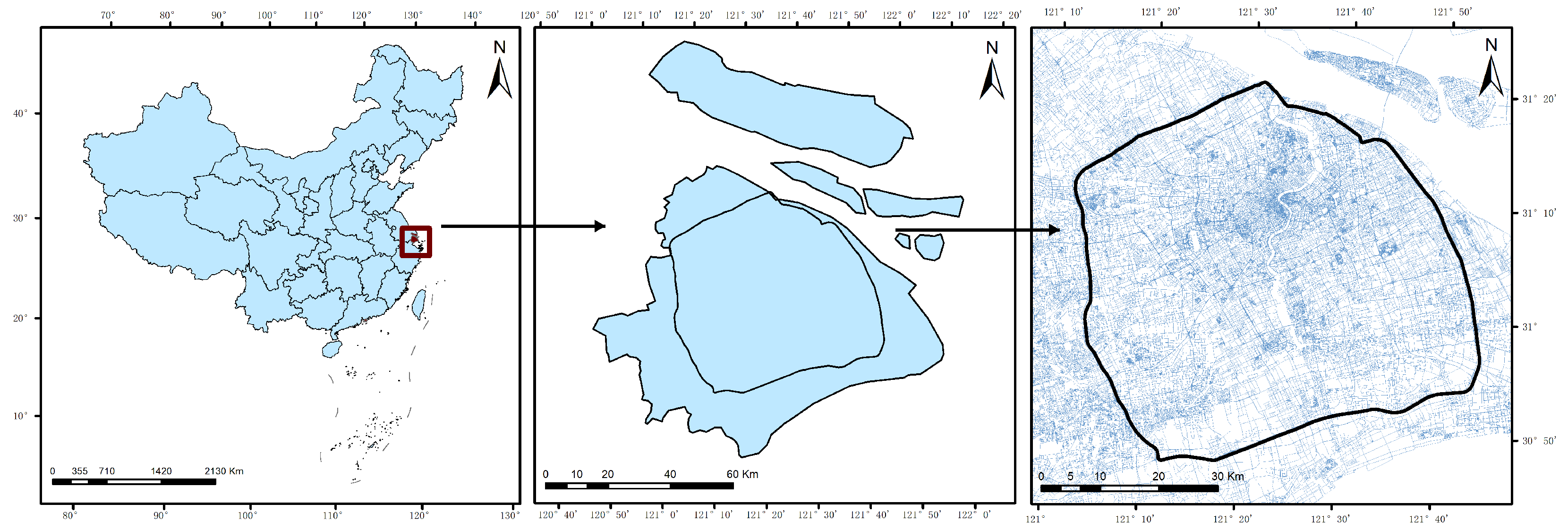
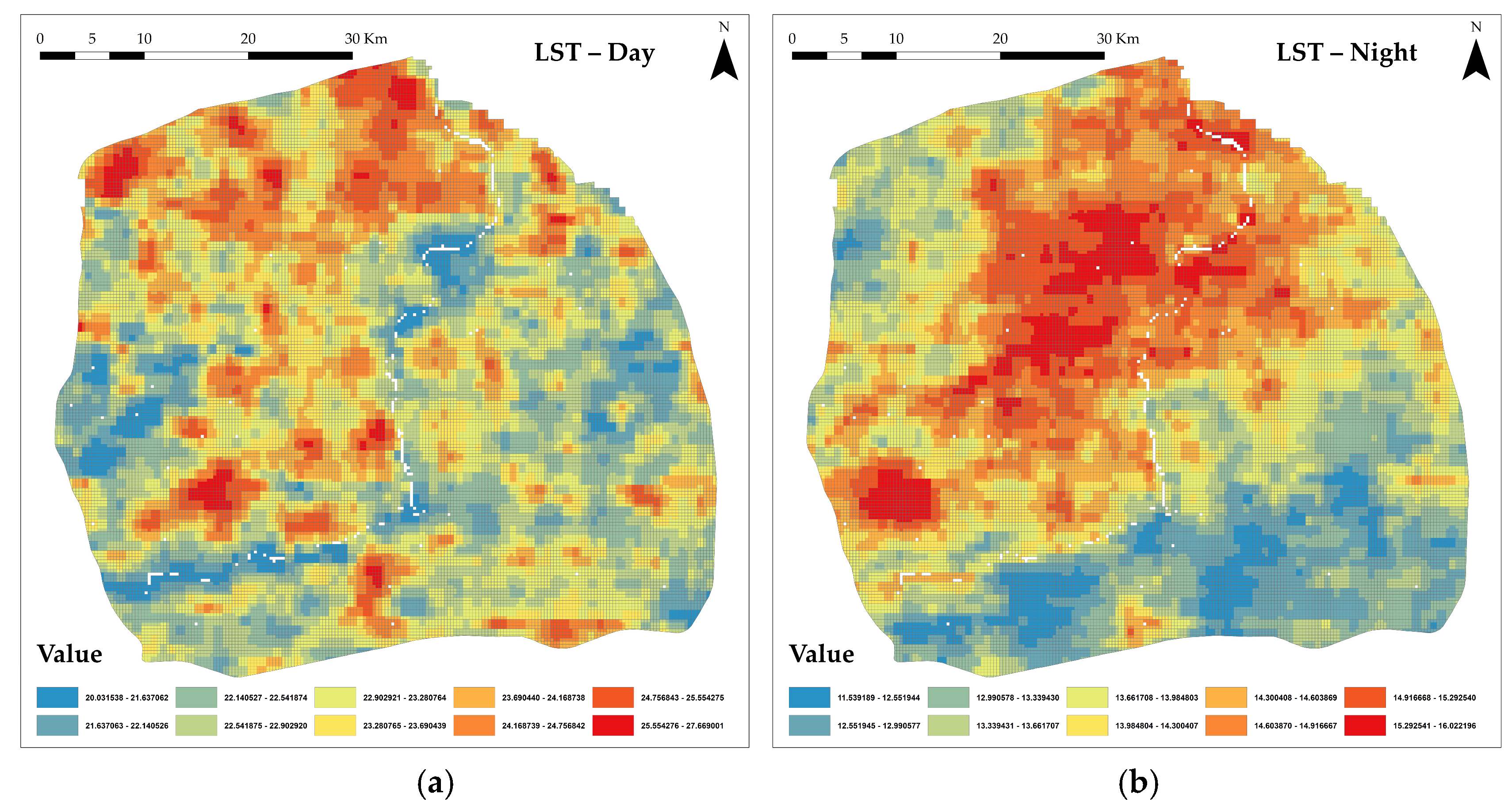
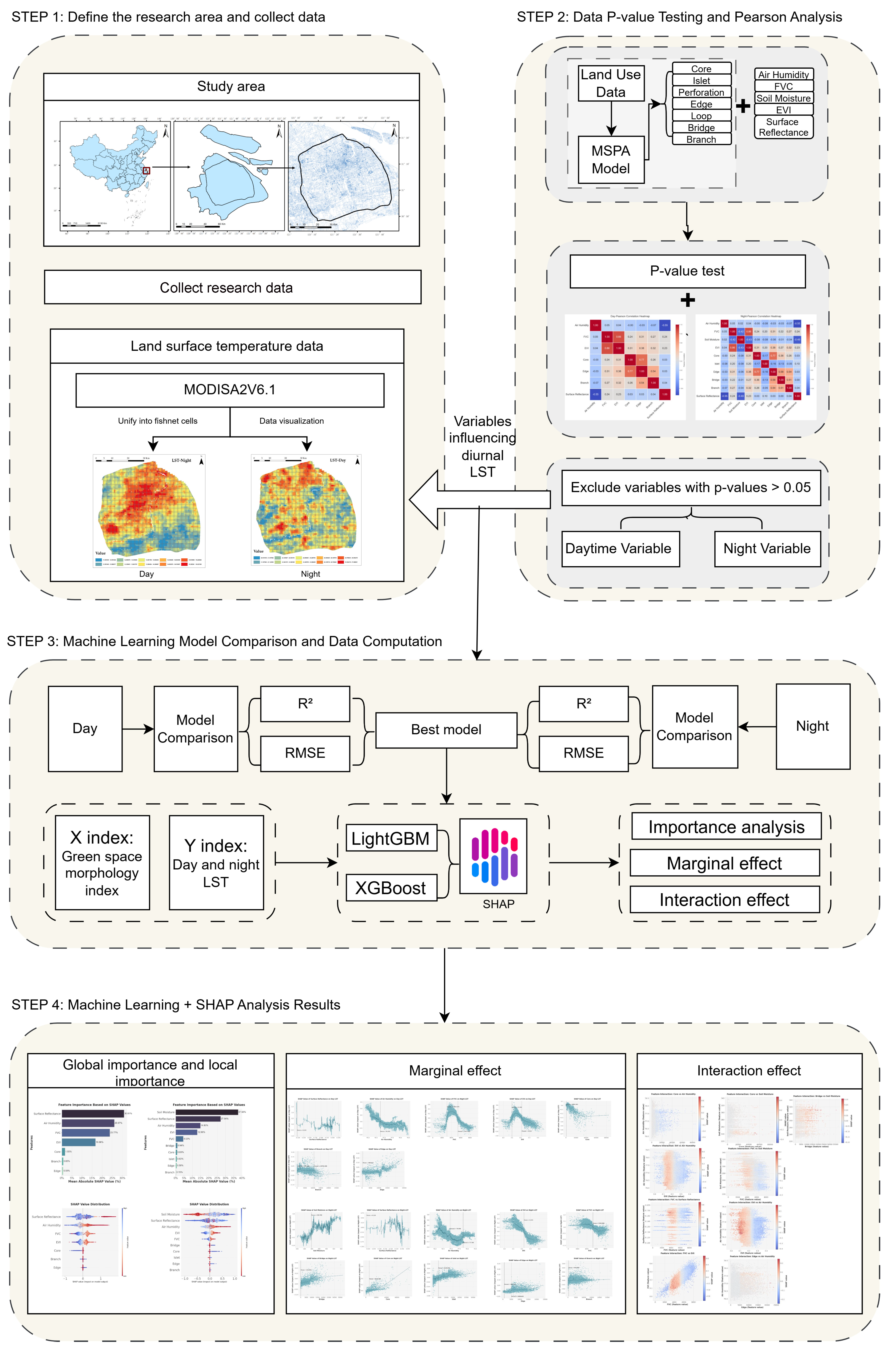
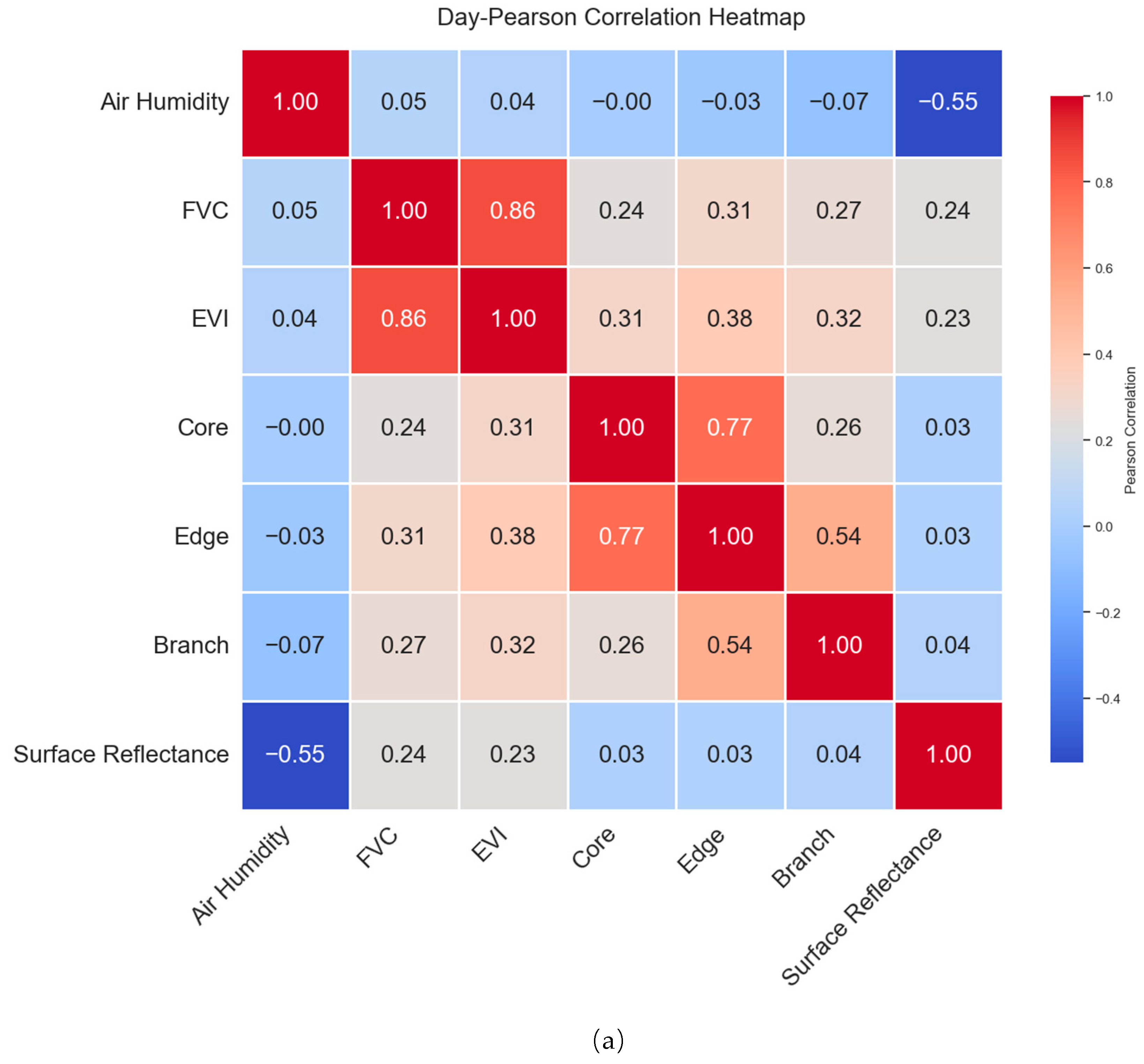
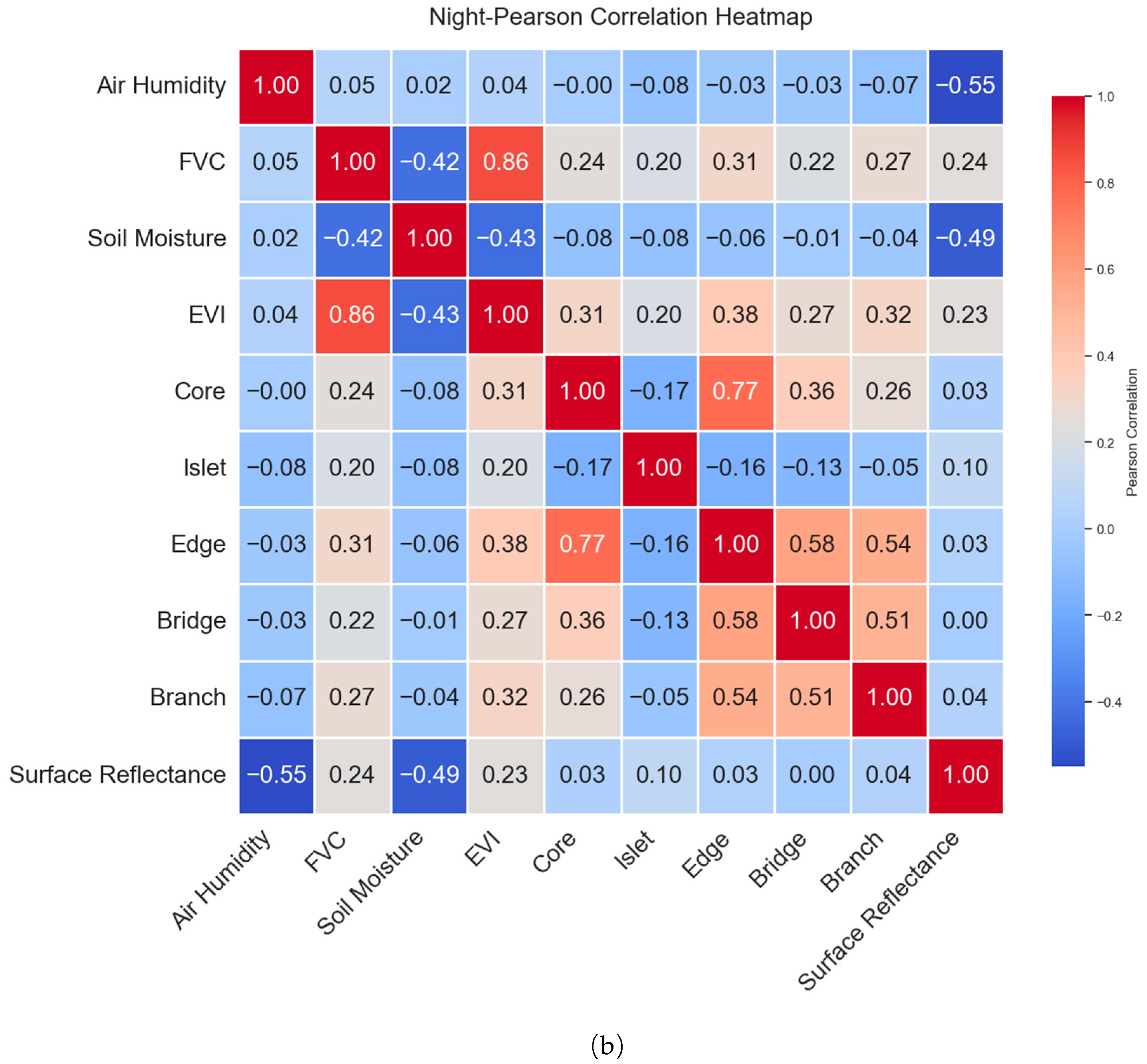

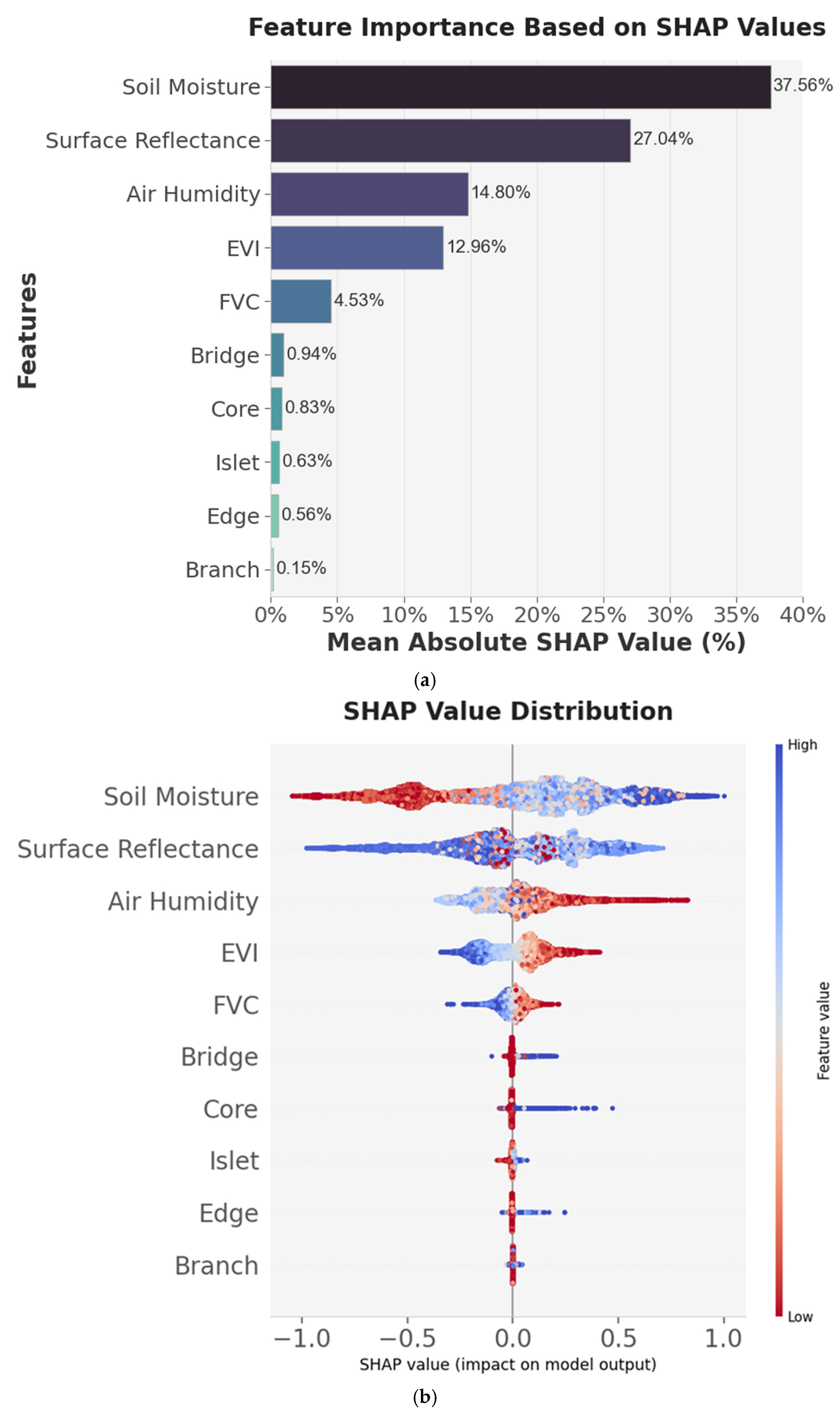


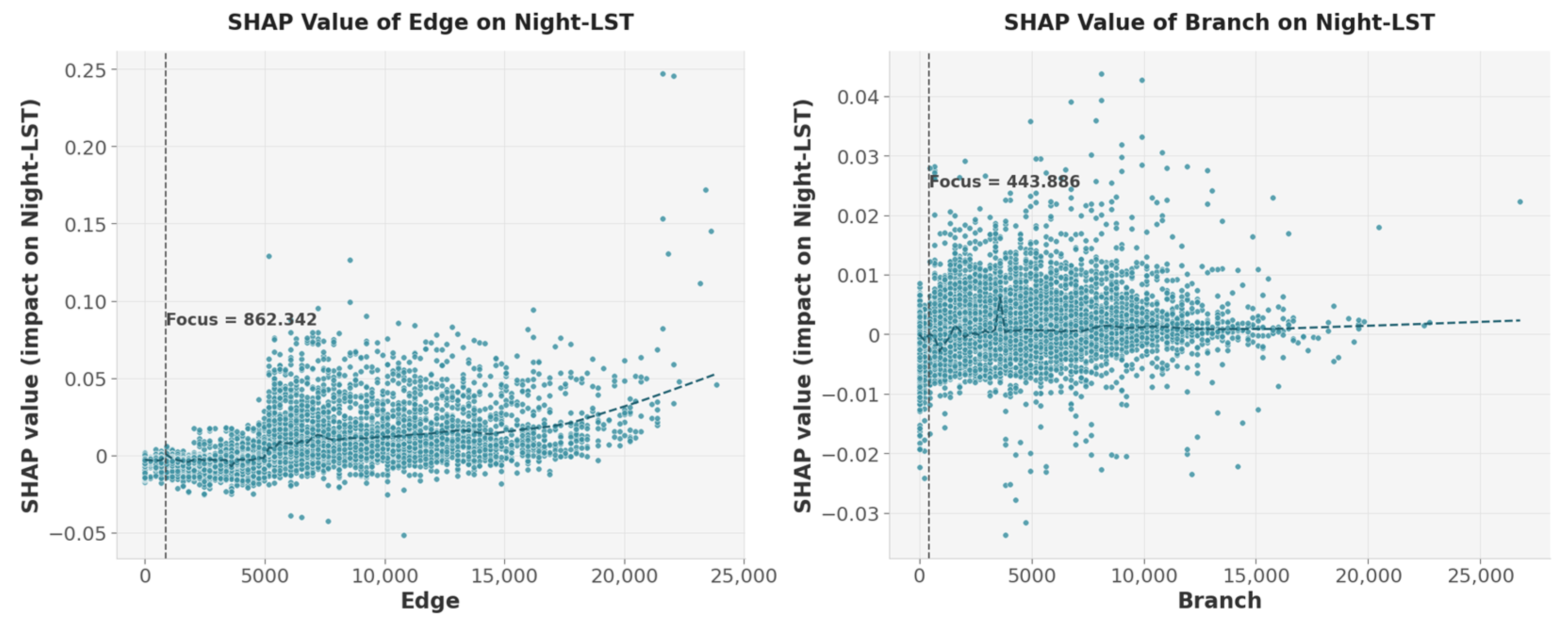

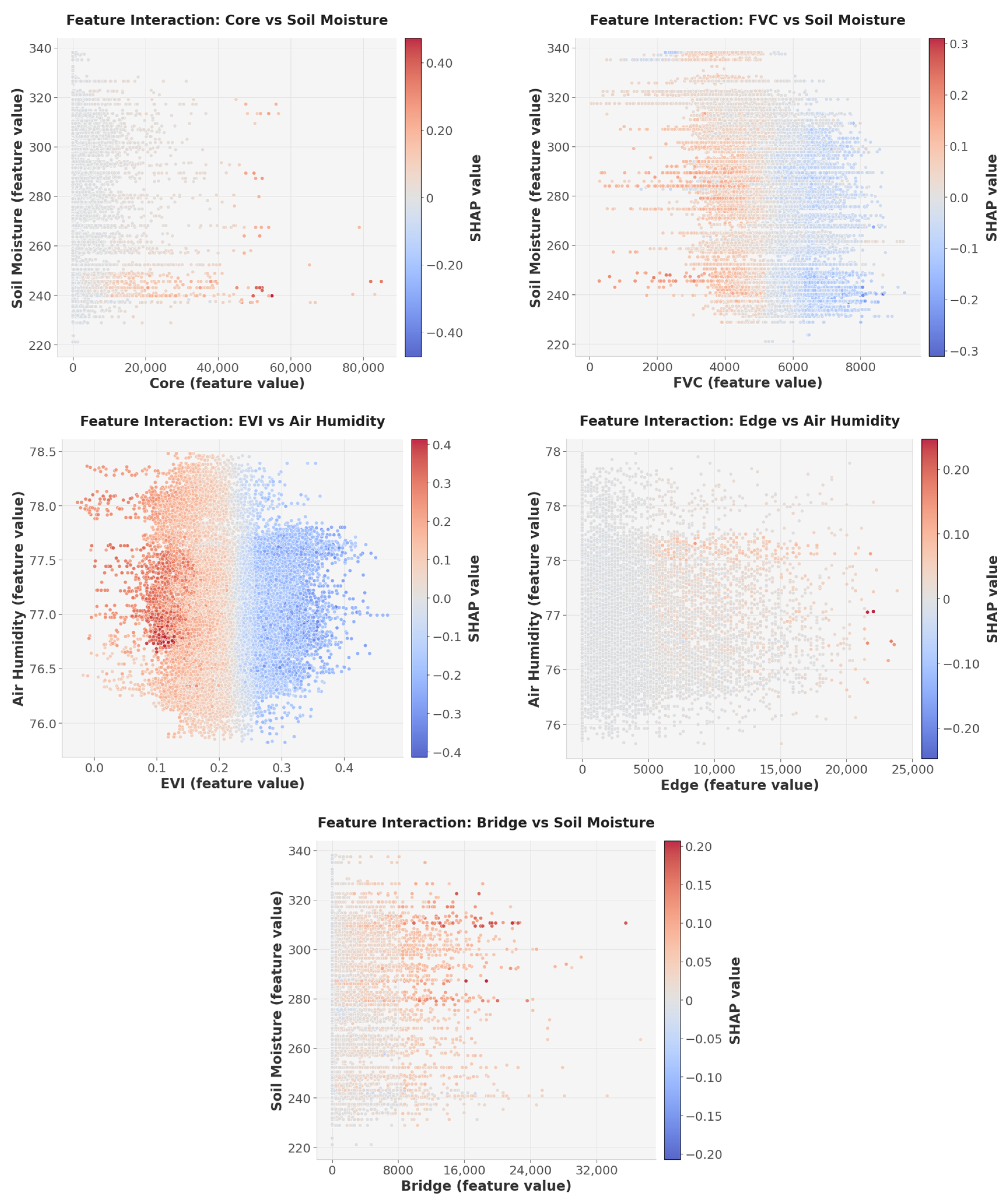
| Morphological Indicators | Definition | Specific Manifestations |
|---|---|---|
| Core | Large habitat patches with high connectivity in the foreground pixels | Large continuous green spaces (e.g., parks, wetlands), ecological function core areas |
| Islet | Small, isolated habitat patches in the foreground pixels | Small island-like green spaces (e.g., street pocket parks) |
| Perforation | Non-green space voids within core patches | Hard surfaces within green spaces (e.g., squares, buildings) |
| Edge | Boundary areas between foreground and background pixels | Boundary edges between green spaces and built-up areas |
| Loop | Foreground pixel corridors forming ring-shaped or closed paths within core areas | Ring-shaped greenways or closed vegetation belts within green spaces |
| Bridge | Foreground pixel corridors connecting at least two core patches | Linear green corridors connecting different green spaces (e.g., greenways, sky bridges) |
| Branch | Small branch-like foreground pixels extending from Core, Islet, or Bridge, serving as secondary structures of corridors | Strip-like greenery or fragmented vegetation extending from the edges of green spaces |
| Green Space Variable | Day | Night | ||
|---|---|---|---|---|
| p-Value | VIF-Value | p-Value | VIF-Value | |
| Core | 0.000 | 3.433 | 0.000 | 3.433 |
| Islet | 0.623 | 1.152 | 0.011 | 1.152 |
| Perforation | 0.654 | 1.330 | 0.076 | 1.330 |
| Edge | 0.000 | 4.198 | 0.006 | 4.198 |
| Loop | 0.753 | 1.305 | 0.698 | 1.305 |
| Bridge | 0.525 | 1.761 | 0.000 | 1.761 |
| Branch | 0.036 | 1.940 | 0.037 | 1.940 |
| Air Humidity | 0.000 | 1.681 | 0.000 | 1.681 |
| FVC | 0.000 | 3.943 | 0.000 | 3.943 |
| Soil Moisture | 0.946 | 1.707 | 0.000 | 1.707 |
| EVI | 0.000 | 4.374 | 0.000 | 4.374 |
| Surface Reflectance | 0.000 | 2.174 | 0.000 | 2.174 |
| Model | Day | Night | ||
|---|---|---|---|---|
| R2 | RMSE | R2 | RMSE | |
| LightGBM | 0.590 | 0.620 | 0.857 | 0.321 |
| XGBoost | 0.587 | 0.622 | 0.859 | 0.319 |
| CatBoost | 0.527 | 0.666 | 0.803 | 0.376 |
| Random Forest | 0.464 | 0.709 | 0.781 | 0.397 |
| Decision Tree | 0.436 | 0.727 | 0.750 | 0.424 |
| SVR | 0.228 | 0.851 | 0.417 | 0.648 |
Disclaimer/Publisher’s Note: The statements, opinions and data contained in all publications are solely those of the individual author(s) and contributor(s) and not of MDPI and/or the editor(s). MDPI and/or the editor(s) disclaim responsibility for any injury to people or property resulting from any ideas, methods, instructions or products referred to in the content. |
© 2025 by the authors. Licensee MDPI, Basel, Switzerland. This article is an open access article distributed under the terms and conditions of the Creative Commons Attribution (CC BY) license (https://creativecommons.org/licenses/by/4.0/).
Share and Cite
Shu, M.; Lu, Y.; Chen, R.; Chen, K.; Lin, X. Study on the Diurnal Difference of the Impact Mechanism of Urban Green Space on Surface Temperature and Sustainable Planning Strategies. Sustainability 2025, 17, 10193. https://doi.org/10.3390/su172210193
Shu M, Lu Y, Chen R, Chen K, Lin X. Study on the Diurnal Difference of the Impact Mechanism of Urban Green Space on Surface Temperature and Sustainable Planning Strategies. Sustainability. 2025; 17(22):10193. https://doi.org/10.3390/su172210193
Chicago/Turabian StyleShu, Mengrong, Yichen Lu, Rongxiang Chen, Kaida Chen, and Xiaojie Lin. 2025. "Study on the Diurnal Difference of the Impact Mechanism of Urban Green Space on Surface Temperature and Sustainable Planning Strategies" Sustainability 17, no. 22: 10193. https://doi.org/10.3390/su172210193
APA StyleShu, M., Lu, Y., Chen, R., Chen, K., & Lin, X. (2025). Study on the Diurnal Difference of the Impact Mechanism of Urban Green Space on Surface Temperature and Sustainable Planning Strategies. Sustainability, 17(22), 10193. https://doi.org/10.3390/su172210193








